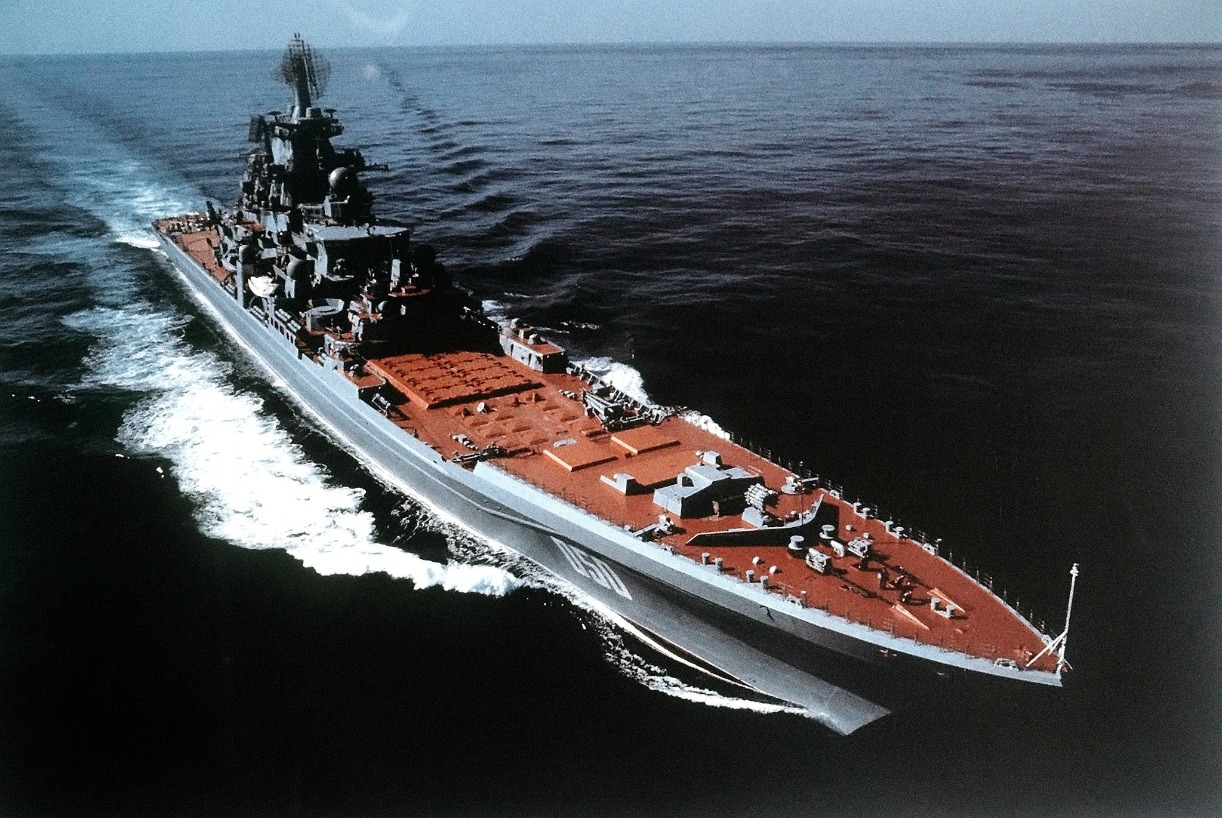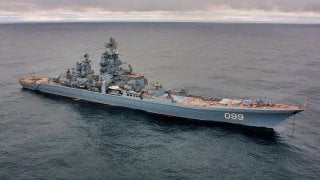Russia’s Kirov-Class Nuclear-Powered Battlecruiser 'Has Outlived Its Usefulness'
Russia’s Kirov-class nuclear-powered battlecruiser, a symbol of late Soviet naval power, has outlived its usefulness in the modern maritime battlefield.
Summary and Key Points: Russia’s Kirov-class nuclear-powered battlecruiser, a symbol of late Soviet naval power, has outlived its usefulness in the modern naval battlefield.
-The remaining vessel, Pyotr Velikiy, suffers from numerous issues, including outdated systems, safety concerns over aging nuclear reactors, and high operational costs.
-Designed for a Cold War threat environment, the ship is vulnerable to modern anti-ship missiles and requires a large crew, which Russia struggles to maintain.
-Given the maintenance costs, crewing issues, and limited deployment utility, Russia would be wise to decommission Pyotr Velikiy and invest in more relevant, cost-effective naval assets for contemporary warfare.
Russia’s Aging Kirov-Class Battlecruiser: Time to Retire the Giant?
Russia’s Kirov-class nuclear-powered battlecruiser dates back to the 1980s. A product of the late-stage Soviet empire, it was designed to be the main capital ship of the Soviet Navy. As of 2014, there is only one ship of this class, the Pyotr Velikiy, remains in service. While these vessels were once considered the symbol of Soviet naval power, they have been kept basically on life support by the Russian Federation.
In fact, the Kirov-class battlecruiser has never lived up to its promise. What’s more, in the age of anti-access/area-denial (A2/AD), in which surface warships will be prevented from moving close to land targets, the Kirov-class is essentially obsolete.
So, it’s time for Moscow to retire these ancient behemoths.
The Specifications on the Kirov-Class
The Kirov-class battlecruiser displaces 24,300 tons (standard and a total of 28,000 tons when fully loaded. The length is 252 meters (827 feet). Its beam is 28.5 meters (93.5 feet). The Draught is 9.1 meters (30 feet). Russia’s Kirov-class battlecruiser’s propulsion possesses two nuclear reactors, two steam turbines, four propellers, and 140,000 shaft horsepower.
These boats reach a top cruising speed of 32 knots (or 37 miles per hour), with an unlimited range because of its nuclear propulsion. Around 830 crewmembers comprise the crew of this class of battlecruiser.
The History
There have been four warships of this class since 1980. Originally named the Leonid Brezhnev, the first warship of this class was renamed the Kirov in 1992 and subsequently decommissioned in 1999. The Frunzeis another boat of this class. Commissioned in 1984 and later renamed Admiral Ushakov in 1992, this unit was ultimately decommissioned in 2001. The Kalinin was commissioned in 1988. In typical Russian fashion, the boat was renamed Admiral Lazarev in 1992 and decommissioned in 2021.
And, of course, there’s the Pyotr Velikiy, which is the last of its class.
The Kirov-class battlecruisers played a major role in the Cold War, projecting Soviet power in the Atlantic and Pacific Oceans. Their operational history has been marred by several incidents and accidents, including the accidental explosion of the Kirov’s nuclear reactor in 1990, which, naturally, led to its decommissioning.
A typical Kirov-class battlecruiser is afflicted with a multiplicity of problems, meaning that it is utterly nonsensical for Moscow to make these boats the flagship of their fleet. Yet, that is precisely what they did. With one left, Moscow should put it out of its misery. The age and maintenance of the Kirov-class is one notable concern. Being over 30 years old, requiring extensive maintenance and constant upgrades to remain operational (and relevant on the modern naval battlefield), this boat is both costly and time-consuming for a Russia that today needs simplicity and cheapness.
Technical Problems Galore for Kirov Battlecruisers
Another hallmark of Soviet-era nuclear technology, such as the nuclear reactors that power the Kirov-class, are its utter unreliable (and unsafe design). The age alone of the nuclear reactors onboard their leviathans give many outside observers pause. Just a decade into its lifespan—relatively young in the ship’s operational history—the namesake of this class suffered a catastrophic nuclear event. Imagine how unsafe the Pyotr Velikiy must be today.
As was mentioned earlier, the Kirov-class has a very limited utility for Russia in the modern battlespace. These were designed for a Cold War-era threat environment, which simply no longer exists. Their large size and limited speed make these boats vulnerable to modern anti-ship missiles and other advanced weapons.
Further, there are crewing issues with this class of warship.
There’s a considerable lack of automation, meaning that the Kirov-class battlecruiser’s size demands a large crew complement. But the Russian Navy in particular is struggling through a recruitment and retention crisis, meaning that keeping the Kirov-class staffed will be a serious problem.

Nuclear warships are more complex than non-nuclear platforms. All this means in a Russia that does not want to waste its money is that the Kirov-class is very expensive to operate safely. They also consume considerable resources that Russia could better spend elsewhere, on systems more relevant to the modern combat arena.
Even though nuclear systems are more complex than non-nuclear ones, these systems exist on a spectrum. So, while the Kirov-class is more advanced than a non-nuclear battlecruiser, it is chock full of obsolete systems from the Soviet era. These warships lack modern sensors, communications, and weapons systems, making them far less effective in modern combat scenarios than warships of this size and cost should be.
Due to their age and operational limitations, these warships have seen limited deployment in recent years, reducing their overall utility to the Russian Navy—especially in a time of war. Russia needs every platform it can get. The Kirov-class battlecruiser simply doesn’t deliver.
Then there’s the whole nuclear concern.
You see, even if the one remaining Kirov-class doesn’t suffer a nuclear reactor meltdown due to mismanagement or age (or both), once Moscow opts to decommission this boat, there might be a nuclear incident simply because the Russian Navy doesn’t want to spend the time or resources to decommission this boat properly. If the radioactive materials are not disposed of properly by the Russian government, it could create a long-term environmental disaster.
This would not be the first time an improperly decommissioned Russian warship created nuclear environmental problems.
Russia Would Be Wise to Spend Their Resources Elsewhere
Russia’s Kirov-class battlecruiser was never worth the rubles and resources that Moscow spent on it. If Moscow were smart, they’d decommission the Pyotr Veliky, and spend the freed-up resources on more advanced systems or cheaper unmanned underwater vehicles (UUV).
Author Experience and Expertise: Brandon J. Weichert
Brandon J. Weichert, a National Interest national security analyst, is a former Congressional staffer and geopolitical analyst who is a contributor at The Washington Times, the Asia Times, and The-Pipeline. He is the author of Winning Space: How America Remains a Superpower, Biohacked: China’s Race to Control Life, and The Shadow War: Iran’s Quest for Supremacy. His next book, A Disaster of Our Own Making: How the West Lost Ukraine, is due October 22 from Encounter Books. Weichert can be followed via Twitter @WeTheBrandon.
All images are Creative Commons or Shutterstock.
From the Vault
Russia Freaked Out: Why the U.S. Navy 'Unretired' the Iowa-Class Battleships
Battleship vs. Battlecruiser: Iowa-Class vs. Russia's Kirov-Class (Who Wins?)


